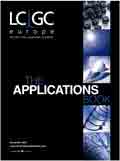Analysis of Organic Acid Preservatives in Food with the PerkinElmer Flexar FX-15 UHPLC System
PerkinElmer Application Note
Njies Pedjie, PerkinElmer, Shelton, Connecticut, USA.
Introduction
In food, organic acids originate from the natural biochemistry processes or are added as preservatives, acidulants and stabilizers. Organic acids contribute to the sensory properties of foods by providing taste and aroma. Citric acid is widely used in soft drinks to provide them with the sour taste of citrus fruit. In the food industry, organic acids are used as antimicrobial agents: formic acid is used as a preservative agent in livestock feeds where it can kill salmonella bacteria.
Analysis of organic acids by reverse phase liquid chromatography is challenging because they have low retention factors and therefore elute close, or within the void volume.
This application note presents a robust UHPLC method for the analysis of some commonly used organic acids. In addition to the method condition, precision and linearity data for formic acid, d-isoascorbic acid, acetic acid, citric acid, fumaric acid and proprionic acid are presented. Red wine vinegar and lemon juice will be analysed and the acid type and concentration confirmed.
Experimental
A PerkinElmer Flexar FX-15 with a Flexar FX Photodiode Array detector provided the UHPLC platform for this application. The separation was achieved with a PerkinElmer Brownlee Analytical C18, 5 μm 100 × 4.6 mm column. The run time was approximately 4.5 minutes with a back pressure of 2000 PSI (138 bars).
Repeatability was studied with six injections of the working standard with concentration ranging from 0.015 mg/mL for fumaric acid to 9.4 mg/mL for proprionic acid. Linearity was determined across a wide range: from 0.1–0.15 μg/mL for fumaric acid to 120–9400 μg/mL for proprionic acid.
Results and Discussion
Optimal resolution and retention was obtained with a pH 2.3 mobile phase. All acid peaks eluted within five minutes. The method performance was outstanding: the linearity of the analysis achieved an average r2 value of 0.9999. Precision was less than 2% relative standard deviation for each acid. A representative chromatogram of the standard solution with annotated peaks is shown in Figure 1.

Figure 1: Chromatogram from the analysis of a standard solution of organic acids.
Conclusion
The method was shown to be linear and peaks were well resolved. The red wine vinegar tested has 6.4% acetic acid well within the requirement of not less than 4% mandated by the FDA. The lemon juice tested has 5.8% of citric acid. PerkinElmer's PDA provides a rugged and accurate detection over a range of 190 nm to 700 nm encompassing UV and Vis wavelengths. PerkinElmer's Chromera software offers many data acquisition and processing features: spectral library creation and peak purity, spectra 3D and contour maps, which are powerful tools for interrogating the information content of a 3D photodiode array chromatogram. The spectra library search function allowed the storage of acids standard spectra that were later used for peak identification and confirmation in the samples.
References
1. L.M.L. Nollet, Food Analysis by HPLC, second edition, April 2000.
2. FDA, CPG Sec.525.825 vinegar.
Flexar is a trademark of PerkinElmer Inc.

PerkinElmer Inc.
940 Winter Street, Waltham, Massachusetts, USA
tel. +1 800 762 4000 fax +1 203 944 4904
Website: www.perkinelmer.com

New Study Reviews Chromatography Methods for Flavonoid Analysis
April 21st 2025Flavonoids are widely used metabolites that carry out various functions in different industries, such as food and cosmetics. Detecting, separating, and quantifying them in fruit species can be a complicated process.
Analytical Challenges in Measuring Migration from Food Contact Materials
November 2nd 2015Food contact materials contain low molecular weight additives and processing aids which can migrate into foods leading to trace levels of contamination. Food safety is ensured through regulations, comprising compositional controls and migration limits, which present a significant analytical challenge to the food industry to ensure compliance and demonstrate due diligence. Of the various analytical approaches, LC-MS/MS has proved to be an essential tool in monitoring migration of target compounds into foods, and more sophisticated approaches such as LC-high resolution MS (Orbitrap) are being increasingly used for untargeted analysis to monitor non-intentionally added substances. This podcast will provide an overview to this area, illustrated with various applications showing current approaches being employed.

.png&w=3840&q=75)

.png&w=3840&q=75)



.png&w=3840&q=75)



.png&w=3840&q=75)












